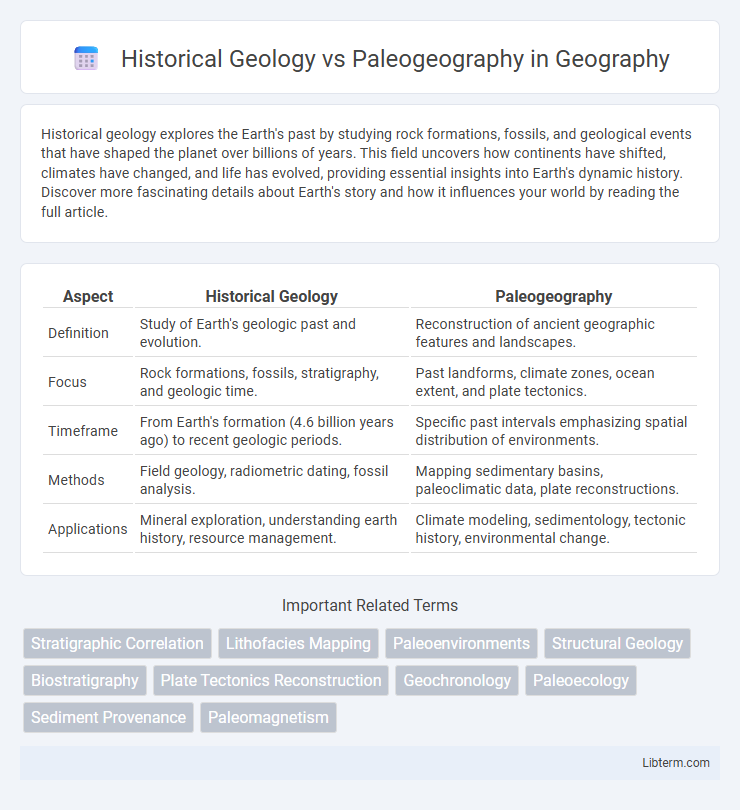Historical geology explores the Earth's past by studying rock formations, fossils, and geological events that have shaped the planet over billions of years. This field uncovers how continents have shifted, climates have changed, and life has evolved, providing essential insights into Earth's dynamic history. Discover more fascinating details about Earth's story and how it influences your world by reading the full article.
Table of Comparison
| Aspect | Historical Geology | Paleogeography |
|---|---|---|
| Definition | Study of Earth's geologic past and evolution. | Reconstruction of ancient geographic features and landscapes. |
| Focus | Rock formations, fossils, stratigraphy, and geologic time. | Past landforms, climate zones, ocean extent, and plate tectonics. |
| Timeframe | From Earth's formation (4.6 billion years ago) to recent geologic periods. | Specific past intervals emphasizing spatial distribution of environments. |
| Methods | Field geology, radiometric dating, fossil analysis. | Mapping sedimentary basins, paleoclimatic data, plate reconstructions. |
| Applications | Mineral exploration, understanding earth history, resource management. | Climate modeling, sedimentology, tectonic history, environmental change. |
Introduction to Historical Geology and Paleogeography
Historical geology explores Earth's physical development through time, emphasizing rock strata, fossil records, and geologic events shaping the planet's surface. Paleogeography reconstructs past geographic environments and plate tectonic movements to understand the historical distribution of continents, oceans, and ecosystems. Both disciplines utilize sedimentology, stratigraphy, and fossil evidence, but historical geology analyzes temporal changes while paleogeography maps spatial configurations of Earth's ancient landscapes.
Definition and Scope: Historical Geology
Historical Geology is the branch of geology that studies Earth's physical development through geological time, focusing on rock formations, fossil records, and tectonic activities to reconstruct past environments and life forms. Its scope encompasses the analysis of stratigraphy, mineralogy, and paleontology to unravel the processes that shaped Earth's crust and biosphere over millions of years. This field provides critical insights into the chronological sequence of geological events and the evolution of the planet's surface.
Definition and Scope: Paleogeography
Paleogeography is the scientific study focused on reconstructing the Earth's past physical landscapes, including ancient coastlines, mountain ranges, and sedimentary basins, based on geological and fossil evidence. It provides spatial context for interpreting the distribution of ecosystems, climatic conditions, and tectonic settings throughout geologic time. Unlike Historical Geology, which broadly examines Earth's history and processes, Paleogeography specifically maps and analyzes the geographic configurations that shaped past environments.
Key Methods in Historical Geology
Historical geology employs stratigraphy, radiometric dating, and fossil analysis to reconstruct Earth's past environments and geological events, providing a chronological framework for Earth's history. Paleogeography uses sedimentology, paleomagnetism, and plate tectonics to map ancient landforms and ocean distributions, revealing spatial patterns of past geological features. Stratigraphic correlation and isotope geochemistry are pivotal in historical geology for dating rock layers and understanding Earth's evolutionary timeline.
Techniques in Paleogeography Mapping
Paleogeography mapping relies heavily on techniques such as sediment analysis, fossil distribution, and isotopic data to reconstruct past landscapes and continental positions. Remote sensing and GIS (Geographic Information Systems) enable precise spatial visualization and integration of geological data for detailed paleogeographic maps. These methods contrast with Historical Geology's broader focus on stratigraphy and tectonic history, emphasizing temporal changes rather than spatial reconstructions.
Major Discoveries in Historical Geology
Historical geology has uncovered major discoveries such as the identification of rock strata and fossil records that reveal Earth's chronological development over millions of years. The theory of plate tectonics, which explains continental drift and mountain formation, revolutionized the understanding of Earth's geodynamic history. Paleogeography complements these findings by reconstructing past landscapes, climates, and ocean distributions, providing context for geological events and evolutionary patterns documented by historical geology.
Notable Paleogeographic Reconstructions
Notable paleogeographic reconstructions provide detailed maps of ancient landmasses, ocean basins, and climatic zones, illustrating Earth's dynamic changes over geological time scales. These reconstructions are essential tools in historical geology for understanding continental drift, plate tectonics, and the distribution of fossils, which collectively reveal past environments and biogeographic patterns. By integrating fossil records, sedimentary data, and structural geology, paleogeography offers insights into Earth's evolutionary history and paleoclimate evolution.
Comparative Analysis: Goals and Applications
Historical geology examines Earth's physical history through rock formations and fossil records to understand geological processes over time, aiming to reconstruct chronological sequences of events. Paleogeography focuses on studying ancient geographic layouts, including past locations of continents, seas, and climatic zones, to analyze spatial changes and environmental conditions through Earth's history. Comparative analysis reveals historical geology provides temporal frameworks for Earth's history, while paleogeography offers spatial reconstructions essential for interpreting sedimentation patterns, fossil distribution, and tectonic movements.
Interdisciplinary Contributions and Overlaps
Historical geology and paleogeography share significant interdisciplinary contributions, particularly in reconstructing Earth's past environments and geological events. Historical geology focuses on understanding Earth's history through rock formations and fossil records, while paleogeography maps past landscapes and environmental conditions using tectonic, climatic, and biological data. Their overlap is evident in studies of plate tectonics, sedimentology, and paleoclimate, where integrating stratigraphic data with spatial reconstructions provides comprehensive insights into Earth's evolutionary processes.
Future Trends in Historical Geology and Paleogeography
Future trends in historical geology emphasize integrating advanced isotopic dating techniques and machine learning algorithms to refine Earth's chronological frameworks. Paleogeography is increasingly leveraging high-resolution climate models and satellite geospatial data to reconstruct ancient landscapes with greater accuracy. Cross-disciplinary approaches combining genomics and sedimentology are expected to transform both fields, enhancing interpretations of Earth's historical environments and biological evolution.
Historical Geology Infographic

 libterm.com
libterm.com